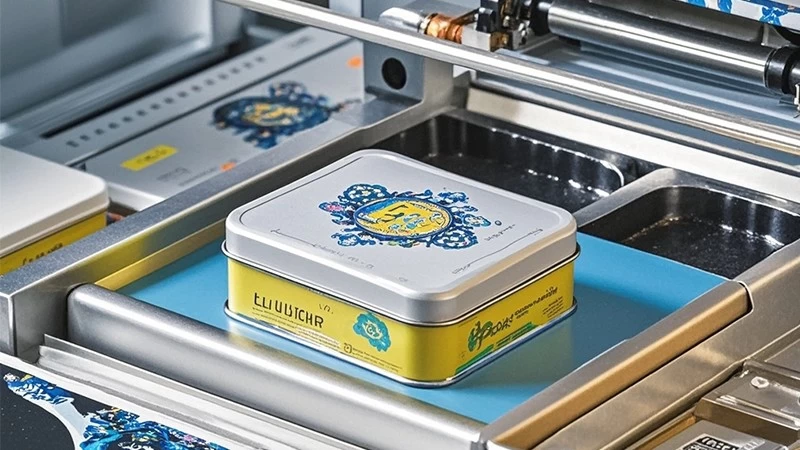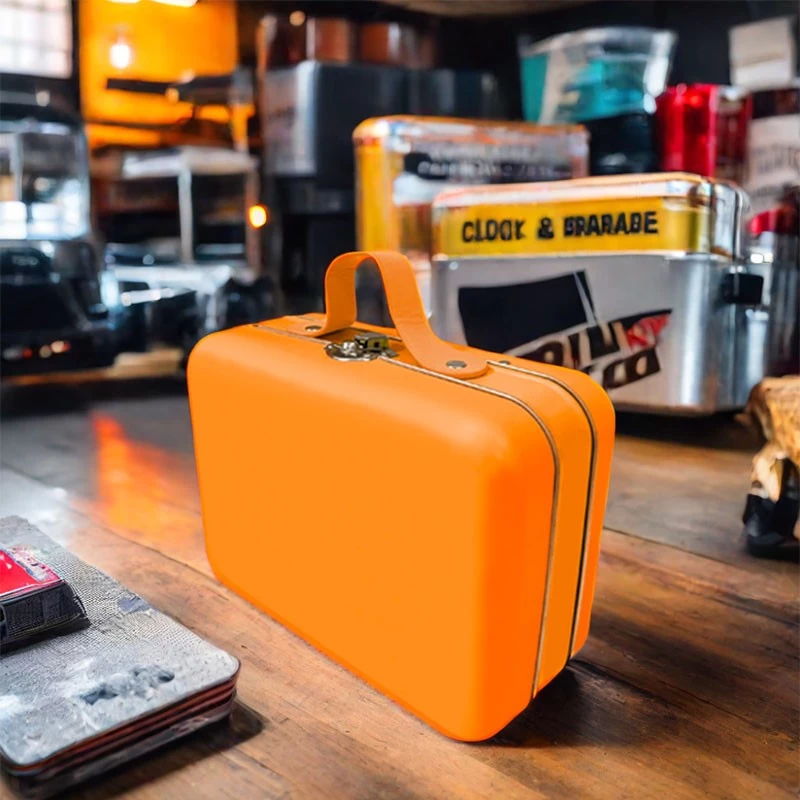This year we carefully created a PU leather handle coffee tin box for the coffee brand. The size is 185x136x85mm. It is made of food-grade tinplate and the material thickness is 0.23mm.
This year, Cosmetics Brands joined hands with our professional tin box manufacturer to create a cosmetic tin box with handle that combines beauty and practicality. This is not only a container for beautiful things, but also an ode to a refined attitude towards life.
The Xmas detachable candy balls is made of tinplate, the iron box is strong and durable. It is not easy to open directly, you can easily open the hemisphere without the string by pulling the string. The Christmas ball can be used as a candy jar, and the candy ball has enough space for candies, chocolates, trinkets, and small things. At the same time, its lovely shape and hanging ribbon are also perfect for Christmas tree decoration
Material and safety Food-grade tinplate material, light and durable, drop-proof and rust-proof, in line with food safety standards. The interior adopts environmentally friendly coating, no odor, and can directly contact food. Customized printing Full-surface high-definition printing: supports single-sided/double-sided customization of corporate logos, patterns, slogans or art designs. Process selection: silk screen printing, hot stamping, UV embossing and other processes are optional to enhance the brand texture. Applicable scenarios: employee benefits, event gifts, promotional gifts, campus customization, etc.
Our round tin cookie box is an elegant and practical packaging solution designed to keep your cookies fresh and beautifully presented. Made from high-quality tinplate, it offers excellent durability and protection against moisture and breakage. The smooth, classic round shape adds a touch of sophistication, making it perfect for gifts, festive treats, or everyday storage. With customizable designs, sizes, and finishes, this tin box not only preserves the delicious taste of your cookies but also enhances your brand’s image with eye-catching, reusable packaging.
This heart-shaped tin box is made from food-grade material, making it safe for storing a variety of candies and gifts. Perfect for the holiday season, this charming tin adds both function and holiday cheer to any celebration.
These discreet low profile rectangle tins feature a clean & fresh style that will remain modern for many uses to come. Our lightweight durable containers are made from high-quality material. Reliable hinge & seal for a perfect closure every time. General household organizing, crafts, homemade packaging, store spices, tea leaves, coffee beans, chocolates, mints, creams, balms, gels, jewelry, beads, sequins, recipe cards, arts, medicines, pills, lip balm, cosmetics, gifts, party favors, Double button locking hinged lid that offers great child resistant packaging.
Designed for exquisite chocolates, our custom food-grade rectangular chocolate tinplate boxes provide safe, beautiful and highly flexible packaging solutions. This packaging box is strictly made of high-quality tinplate materials that meet food contact safety standards (such as FDA/GB) to ensure that the contents are pure and uncontaminated. The classic rectangular design is not only simple and elegant in appearance and full of modernity, but also can efficiently utilize space, making it easy to stack, transport and retail display. The core advantage lies in its deep customization service - you can freely choose the box size, color (internal and external coating), pattern printing (high-definition color printing, hot stamping/silver, etc.), and lining material (such as food-grade white cardboard tray, PET blister tray, flannel, etc.), perfectly carrying and enhancing the value and protection of your brand chocolate. The sturdy iron box structure provides excellent sealing and moisture-proof performance, effectively extending the freshness and shelf life of chocolate, and is an ideal packaging choice for high-end chocolate brands, gift markets and baking industries.
There are many differences between tin box printing and paper box printing in terms of material properties, printing process, design requirements and cost factors. Tin boxes have a metallic texture and strong durability. The printing process is mostly offset printing and silk screen printing. The design needs to consider the shape structure and color reproduction, and the cost is relatively high; paper boxes have a soft texture and diverse shapes and structures. A variety of printing methods and surface treatments can be used, and the cost is easier to control. The choice of packaging method requires comprehensive consideration of product characteristics, market positioning and cost budget.
This article is shared by the tin box factory china. The main differences between tin box printing and paper box printing:

1. Material properties
Texture performance:
Tin box: It has a metallic texture. After printing, the color saturation is high and the gloss is strong, which can present a high-end and solid visual effect. For example, some holiday chocolate tin boxes, biscuit tin boxes, etc., give people a sense of refinement and luxury.
Paper box: usually made of paper material, with a relatively soft texture, different styles can be expressed by choosing different paper weights and textures. For example, art paper can create an elegant atmosphere, while corrugated paper is more rustic.
Durability:
Tin box: relatively strong and durable, with good pressure resistance and moisture resistance, can better protect the internal products. It is not easy to be damaged during transportation and storage, and can be reused. For example, the packaging tin boxes of some electronic products can effectively protect the products from external impact.
Paper box: relatively easy to damage, with poor pressure resistance and moisture resistance. But the paper box is light, easy to process and transport, and the cost is relatively low. For some products that do not require long-term storage or do not require high packaging strength, paper boxes are an economical choice.
2. Printing process
Printing method:
Tin box: generally adopts offset printing, silk screen printing and other printing methods. Offset printing can achieve high-precision color printing, bright colors and rich layers; silk screen printing is suitable for printing special effects, such as metallic colors, fluorescent colors, etc.
Paper box: offset printing, flexographic printing, gravure printing and other printing methods can be used. Offset printing is also suitable for high-quality color printing, flexographic printing is suitable for mass production and has low cost, and gravure printing can print very delicate patterns and texts.
Surface treatment:
Tin box: Surface treatments such as glazing and laminating are usually required to increase the wear resistance and glossiness of the iron box, and also protect the printed pattern. For example, the surface of the iron box after glazing is smoother and not easy to scratch; laminating can make the iron box waterproof and moisture-proof.
Paper box: Various surface treatments such as glazing, laminating, hot stamping, and embossing can be performed. Hot stamping can make the paper box more upscale, and embossing can increase the texture and three-dimensional sense of the paper box. Different surface treatment methods can be selected according to the needs and positioning of the product.
3. Design requirements
Shape and structure:
Box: The shape is relatively regular, generally square, round, etc., and the structure is relatively complex, and may require stamping, welding and other processes. Factors such as the opening method and sealing of the iron box need to be considered during design.
Paper box: The shape and structure are more diverse and can be customized according to the characteristics of the product. The design of paper boxes is relatively flexible, and can adopt folding, card insertion and other structures to facilitate packaging and display of products.
Color and pattern:
Tin box: Due to the particularity of metal materials, the color reproduction degree is required to be high. When designing, it is necessary to consider the reflectivity of metal and the stability of color to avoid color difference. At the same time, the printing area of the iron box is relatively small, and concise and clear patterns and texts are required to highlight the product information.
Paper box: It can be printed on a large area, and the choice of colors and patterns is richer. The design of paper boxes can pay more attention to creativity and personalization, and attract consumers' attention through unique patterns and colors.

4. Cost factors
Material cost:
Tin box: The material cost is relatively high, especially for some special materials of iron boxes, such as tinplate. In addition, the processing technology of tin boxes is complicated, which will also increase the cost.
Paper box: The cost of paper is relatively low, and the production process of paper boxes is relatively simple, and the cost is relatively controllable.
Printing cost:
Tin box: The printing cost is high, mainly because the printing process of iron boxes is relatively complex, requiring professional equipment and technicians. In addition, the printing quantity of tin boxes is generally large, otherwise the cost will be higher.
Paper boxes: The printing cost is relatively low, especially for small batches of printing, paper boxes have obvious advantages. The printing equipment and technology of paper boxes are relatively mature, and the cost is easier to control.
In summary, there are certain differences between tin box printing and paper box printing in terms of material properties, printing process, design requirements and cost factors. When choosing a packaging method, it is necessary to comprehensively consider factors such as product characteristics, market positioning and cost budget.